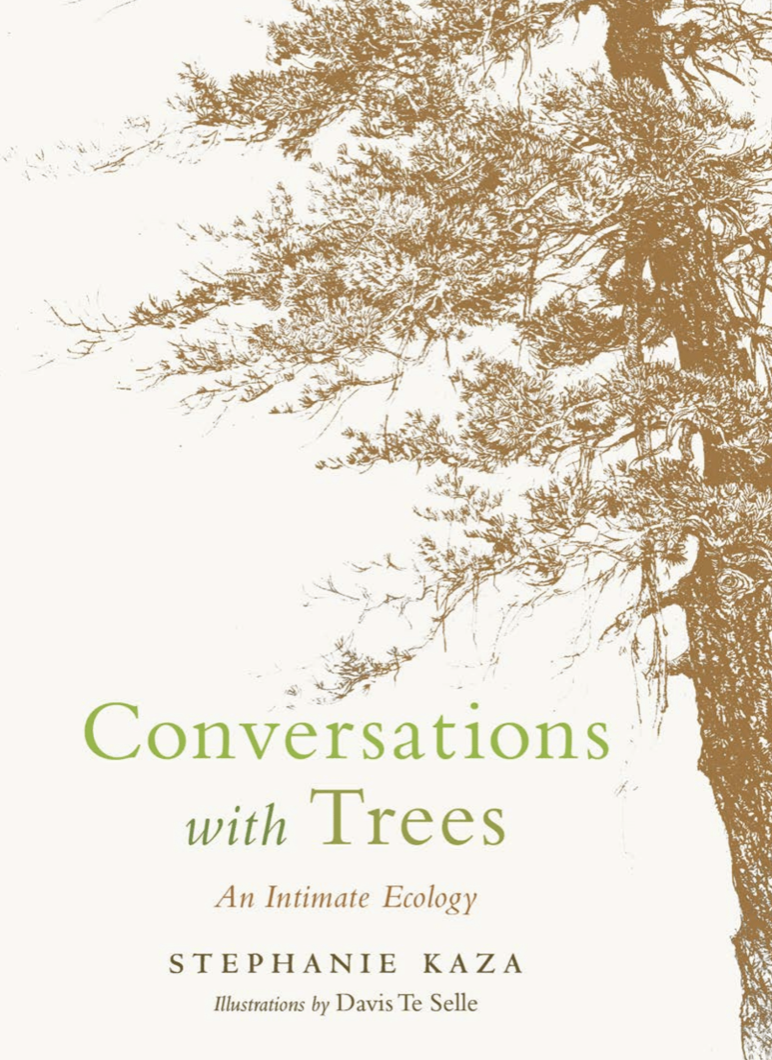
Excerpted from Conversations with Trees by Stephanie Kaza. ~ Ed.
Inside the meditation hall, I sit with my hands in my lap, breathing into the hollow of my palms.
Left hand lying gently inside the right, thumb tips just barely touching, center point of concentration in the posture of Zen meditation. Back straight, mind deep in the body, the hands open and connected to the motion of breathing. I think of the image suggested by the Vietnamese Zen teacher Thich Nhat Hanh—a baby Buddha nestled in my hands, a radiant being in the company of my hands and breath. Let the hands be taught, let the hands absorb the Way of the Buddha and teach the mind.
Outside, the winter creek dances through the rocks, refreshing this small hollow below Skyline Ridge. Evergreen bay laurels cover the quiet spot with shade and whispering. In between periods of meditation, I walk slowly around the deck, drawing in the sweetness of early spring. By midmorning, the land is speaking more powerfully than the meditation hall. Come, come, walk with me, smell the fresh soil, catch the bright sky, come to the trees, come.
The fire road above the retreat center leads down to the pond. From there it is a short walk to the ridgetop. The ridge stretches for 50 miles from San Francisco south to Saratoga Gap, with wide views of the rolling hills on both sides. I head out in my black robes, leaving behind the strict schedule, choosing instead the irresistible pull of the land. Deep, long breaths, each foot touching the earth in slow, rhythmic strides, connecting small body to large body as I walk.
I have barely entered the forest when I see the alders across the pond. The invitation to stop fills my attention; I am riveted by their graceful beauty and still reflection. Alders, I see you from this open spot by the tall Douglas fir. You are very quiet this morning. The light touch of a breeze tickles the pond’s surface, rippling the reflection of your white trunks and open branches. Early April is such a tender time for you—all your fresh green leaves just out, catching their first taste of sunlight. I wonder how it feels for you to stretch out your green hands to the light after months of empty branches.
From this cordial perspective, I am taken by your remarkably clear and detailed reflection. The image forms perfectly in the first quiet hours of the day when the surface tension is light and dynamic. By late afternoon, the surface will be thicker and less responsive to subtle breezes. The pond will fall into shadow, and insects will stir across the face of the water. Right now—moment of mindfulness, right now—moment of impermanence.
Alders, can you feel the beauty of your reflection? Of course not. And yet, this great beauty lies right at your feet. Are you not connected to it in some way? Does not each shining being contribute to the elegance of this entire event? I must come closer. I walk around the lower berm past the cattails.
Now in your presence, I see how straight and elegant you stand, especially next to the gangly willows. Your gray-white dappled trunks are tall and smooth, as if you shot up fast before any injurious forces could do you harm. Your trunks are barely scarred except for the knots from past years’ branches. I extend a shy hand, meeting your body, firm and cool against my skin.
I wonder if a tree knows when someone’s hand is on its body. Does it feel a little warm, like an exchange of electricity? This act of reaching out is a small gesture, but it is filled with great intention. I am simply trying to say hello across the barriers of form and language. I believe the hands communicate this intention most honestly. The voice and mind are not direct enough. Or perhaps they are too complex for the first step of making contact. Besides, the tree and I have such different minds and voices. I don’t know the language of these alders at all. I can only guess at the shape of a tree’s mind and what it knows about life on the edge of a pond. How does this water taste to an alder? How does the morning sun feel on its new leaves? How does the wind feel moving through its branches?
I know a little more about the pond from swimming its warm waters in summer. Created originally for water storage, it is only 100 yards long, 30 yards wide—a filling in of a natural draw through the hills. I can swim from one end to the other in five minutes or lazily cruise the perimeter in 20, checking the mud spots for frogs and turtles. The banks have filled in with willows and cattails, providing hiding places for mallards and marsh wrens. Many times I have heard the sharp rattle of a kingfisher piercing the air overhead.
The prospect of a swim is tempting, but I resist. Today only my hands will go for a dip. Down they go in the still water, shattering the reflection. Down they go, reaching for alder roots, bright red alder roots. Like slender snakes swimming in a tangled mat or my long hair floating behind me when I swim, the roots drift in the water, soaking up the life-giving liquid. Slippery, smooth, wet—how soothing it must be to feel the water move between your toes! The little rootlets sway back and forth in the gentle stirrings of the pond, drinking the sweet water through their root hairs.
Hands in the water, hands on the firm gray trunk, hands exploring the shapes of these trees. I lean out to feel the season’s new leaves—smooth on top, fuzzy below, rough and serrated at the edges. The flowering catkins, now past their peak, still dangling in the shiny canopy. A month ago, the alders bloomed near my house on the coast. The trees were decorated with hundreds of catkins dancing in the wind. The finger-length male catkins were explosive to the touch; if I knocked them lightly, a big poof of yellow pollen would go flying.
Pollen is key to an alder’s reproductive success. Alder flowers, like most flowers, are vulnerable to weather and the potential for missed timing. Deceptively small, less than an eighth of an inch across, the compact rows of tiny flowers can easily become bedraggled in a storm. If it rains hard for several days or weeks after the male pollen matures, all that pollen washes away in the stormwater runoff, never making it to the female flowers. A season of seeds is cut short.
With each week of the new spring season, the alders move further into full greening. I wonder how these waves of productivity feel after the quiet time of winter. Does the new activity make you tingle? Do you experience the returning of the long days of the sun as pleasant, as dynamic?
It is difficult to imagine the scale and complexity of activity that goes on inside a tree. I sense in my hands some charge, some energetic force at work here. Joining palms to trunk, I form a circle of energy with this tree. Listening through my hands, I meet this tree from my own experience of sunlight and stillness. Bound to a single place, perhaps the tree delights in the simple rhythm of the changing day. Maybe it is similar to sitting in the meditation hall, watching the day go by when there is nothing else to do. First the day begins, then it unfolds, and soon it closes down, and the night sky appears.
Day after day the rhythm repeats, shaping the tree’s life through the seasons. The tree itself is a manifestation of rhythm, of the way the light works. Supple trunk, dainty flowers, fresh green foliage—all are testimony to this pattern of change. This is what my hands recognize—this movement of sun, earth, and water. At some fundamental level, this tree and I are made of the same rhythms. We share a common understanding, available in the meeting place of touch. Reaching out, I find a simple way to begin a conversation. Coming close, I offer my hands in greeting.
~
From Conversations with Trees by Stephanie Kaza © 1993 by Stephanie Kaza. Reprinted in arrangement with Shambhala Publications, Inc. Boulder, CO.






Read 1 comment and reply